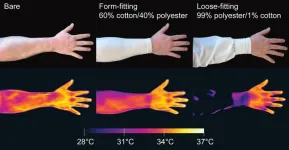(Press-News.org) Primate ornamentation plays a crucial role in communication not only within social groups but also between them, according to a new study. The research reveals that the males of species with overlapping home ranges often display vibrant colors or elaborate features, traits that may help reduce intergroup aggression by enabling quick assessments of potential rivals.
Ornaments are sexually selected traits that serve as powerful signals, often indicating an individual’s genetic quality, health or physical strength. These differences in appearance between males and females, known as dimorphic traits, are expressed in features like colorful fur or elaborate body structures. Examples include the golden snub-nosed monkey’s lip wart and blueish face, the mandrill’s vivid facial features with its red nose and blue skin, the gelada baboon’s impressive mane and red chest patch, or the proboscis monkey’s remarkably large nose.
A new study from the University of Zurich (UZH) has uncovered an intriguing link between these dimorphic traits and how primates interact with other groups. The research, conducted by Stefan Lüpold from the Department of Evolutionary Biology and Environmental Studies at UZH in collaboration with Cyril Grueter from the University of Western Australia, shows that the vibrant colors and elaborate body ornaments seen in many primate species may do more than attract mates or establish social hierarchies. These features also play an important role in communication between different social groups.
Proximity encourages richer ornamentation
The researchers analyzed data from 144 primate species, including both monkeys and apes (prosimians and anthropoids). They focused on how ornamentation relates to the overlap of home ranges, which measures how much living space groups share with their neighbors. According to Stefan Lüpold, the findings showed a clear pattern: “Species that shared more space with their neighbors had significantly greater differences in ornamentation between the sexes. In species where groups frequently interact, males are more likely to sport flashy traits that set them apart from females.”
The study also found that intergroup encounters were less likely to be aggressive in species with greater home range overlap. Encounters deemed conflict-related included behaviors such as physical confrontation, displays of strength, avoidance, displacement, vigilance and vocal warnings. This suggests that vivid physical traits might help to reduce conflict between groups, possibly by allowing them to quickly assess potential rivals from a distance.
Complex world of animal communication
“These findings challenge the common belief that primate ornamentation is only about competing for mates within groups,” says Lüpold. “Instead, they highlight the importance of considering the wider social environment in which gregarious animals exist, recognizing the significance of social interactions both within and between groups.” The study sheds new light on the evolution of primate ornamentation and provides valuable insights into the complex world of animal communication.
END
Colorful traits in primates ease tensions between groups
2024-08-23
ELSE PRESS RELEASES FROM THIS DATE:
Sylvester Cancer Tip Sheet for August 2024
2024-08-23
AUGUST 2024 TIP SHEET: A mouthwash-like rinse to predict head and neck cancer recurrence, new research identifies biomarkers to predict which colon cancer patients benefit from adjuvant chemotherapy, the Dolphins Cancer Challenge and StacheStrong team up to boost brain cancer research, the CDC issues anal cancer screening guidelines for HIV patients based partly on research at Sylvester, and three Sylvester physicians who become the latest early-career faculty scholars are highlighted in this month’s tip sheet from Sylvester Comprehensive ...
Weight loss drug’s heart benefits extend to people with heart failure
2024-08-23
The anti-obesity medication semaglutide may help to prevent heart attacks and other major adverse cardiac events among overweight people who have cardiovascular disease, whether or not they also have heart failure, according to a new study led by UCL’s Professor John Deanfield.
The results follow previous research* from the same international team finding that weekly injections of semaglutide were linked to a 20% reduction in major adverse cardiac events (MACE) such as heart attacks and strokes for people with obesity or who were overweight and had cardiovascular disease.
The ...
Declining senses can impact mental health and loneliness in aging adults
2024-08-23
Most people — up to 94% of U.S. adults — experience at least some dulling of their senses with age, finding themselves squinting at screens, craving stronger flavors, and missing snatches of conversations more and more frequently. Researchers at the University of Chicago Medicine are looking into how these changes can go beyond mere inconvenience and actually worsen overall mental health in older adults.
“When your senses decline, you can't experience the world as well,” said Jayant Pinto, MD, a physician ...
NASA’s EXCITE mission prepared for scientific balloon flight
2024-08-23
Scientists and engineers are ready to fly an infrared mission called EXCITE (EXoplanet Climate Infrared TElescope) to the edge of space.
EXCITE is designed to study atmospheres around exoplanets, or worlds beyond our solar system, during circumpolar long-duration scientific balloon flights. But first, it must complete a test flight during NASA’s fall 2024 scientific ballooning campaign from Fort Sumner, New Mexico.
“EXCITE can give us a three-dimensional picture of a planet’s atmosphere and temperature by collecting data the whole time the world orbits its star,” said Peter Nagler, the mission’s principal ...
New gels could protect buildings during wildfires
2024-08-23
As climate change creates hotter, drier conditions, we are seeing longer fire seasons with larger, more frequent wildfires. In recent years, catastrophic wildfires have destroyed homes and infrastructure, caused devastating losses in lives and livelihoods of people living in affected areas, and damaged wildland resources and the economy. We need new solutions to fight wildfires and protect areas from damage.
Researchers at Stanford have developed a water-enhancing gel that could be sprayed on homes and critical infrastructure to help keep them from burning during wildfires. The research, published Aug. ...
U.S. National Science Foundation awards UT $18 million to study factors that lead to pandemics
2024-08-22
Professor of Ecology and Evolutionary Biology Nina Fefferman became a mathematician because she loves puzzles. She’s just been awarded $18 million from the U.S. National Science Foundation to solve one puzzle that has the potential to change the world: how, when and why an infection in a population will spread, or cause an epidemic or pandemic, rather than dying out.
Fefferman, director of the National Institute for Modeling Biological Systems and associate director of the UT One Health Initiative at the University ...
Mosquitoes sense infrared from body heat to help track humans down
2024-08-22
(Santa Barbara, Calif.) — While a mosquito bite is often no more than a temporary bother, in many parts of the world it can be scary. One mosquito species, Aedes aegypti, spreads the viruses that cause over 100,000,000 cases of dengue, yellow fever, Zika and other diseases every year. Another, Anopheles gambiae, spreads the parasite that causes malaria. The World Health Organization estimates that malaria alone causes more than 400,000 deaths every year. Indeed, their capacity to transmit disease has earned mosquitoes the title of deadliest ...
DOD grants CU researchers $5 Million to study antibiotic-resistant wound infections in Ukraine
2024-08-22
Faculty members in the Department of Emergency Medicine at the University of Colorado School of Medicine have been awarded $5 million by the U.S. Department of Defense to work with partners in Ukraine on clinical and logistical challenges associated with modern large-scale combat operations and prolonged casualty care.
The overarching program — Research and Scalable Infrastructure to Improve Outcomes on the Front Lines of Ukraine by Advancing Treatment and Evaluation (RESOLUTE) — is focusing on collecting data related to antibiotic-resistant wound infections, which have substantially increased amid the military conflict.
The initial project — ...
3D body volume scanner uses AI to help predict metabolic syndrome risk
2024-08-22
ROCHESTER, Minn. — Mayo Clinic researchers are using artificial intelligence (AI) with an advanced 3D body-volume scanner – originally developed for the clothing industry – to help doctors predict metabolic syndrome risk and severity. The combination of tools offers doctors a more precise alternative to other measures of disease risk like body mass index (BMI) and waist-to-hip ratio, according to findings published in the European Heart Journal - Digital Health.
Metabolic syndrome can lead to heart attack, stroke and other serious health issues and affects over a third of the U.S. population and a quarter of people globally. ...
Building a COMPASS to navigate future pandemics
2024-08-22
Viruses like SARS-CoV-2 don’t respect boundaries, moving between species and continents and leaving destruction as they go. Beating the next pathogen with pandemic potential means getting good at crossing borders ourselves — between fields of study, between research universities, and between scientists and the wider community.
An $18 million grant announced by the U.S. National Science Foundation (NSF) will put that goal within reach. The award brings together five universities and more than 20 researchers, academics, and public health experts to establish the Virginia Tech-led Center ...





